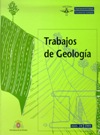Abstract
Computer modelling of fold profiles formed by a specific folding mechanism is possible when the equations to find transformation relationships from points of the initial configuration to points of the folded configuration of the layer are known. From these equations, folds formed by the successive or simultaneous superposition of tangential longitudinal strain, flexural flow and several types of homogeneous strain (layer shortening, compaction, and fold flattening parallel or perpendicular to the axial trace) have been modelled. The geometry and strain pattern of the theoretical folds allow predictions about the characteristics of natural folds formed by the above mechanisms. The strain state in the folded layer is a typical feature of every mechanism or mechanism superposition and it can be described by two types of curves, which show the variation of the major axis plunge of the strain ellipse and the variation of the aspect ratio of this ellipse with the layer dip. Tangential longitudinal strain is the only mechanism analysed that produces different curves for the two boundaries of the folded layer. Ramsay’s classification or classifications based on parameters derived from it also give results specific for every folding mechanism or mechanism superposition. Analysis of folding mechanisms that operated in a specific natural fold can be made by trial and error modelling a fold with the same geometrical characteristics as the natural fold. The geometrical features to be analysed in the latter are those involved in the modelling. In natural folds with cleavage, an approach to the curve of the major axis plunge of the strain ellipse against the layer dip can be obtained by measuring the dip variation of the cleavage as a function of the layer dip. The greatest problem in the kinematical analysis of folding is posed by the difficulty of obtaining strain measurements in folded rocks.Downloads
Download data is not yet available.

